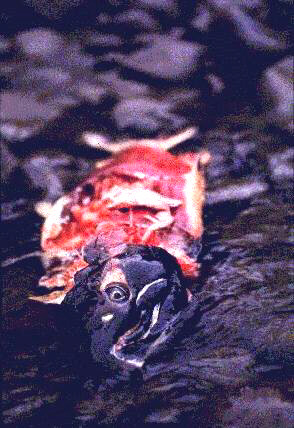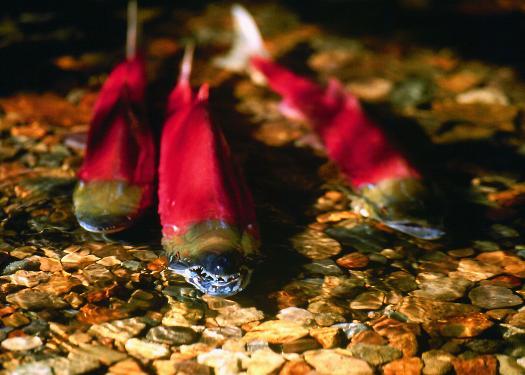

Symposium summary:
Reproductive success (RS) in salmonids is a subject with broad appeal and relevance. Salmonids have been used to develop and test models of life history evolution, sexual selection, and alternative reproductive tactics. Many species in this group are also of great economic and cultural importance, and have been studied from a conservation perspective. Of particular interest in this respect are metapopulation dynamics (homing and straying), and interactions between hatchery and wild fish. Quantifying reproductive success is central to all of these issues.
Key areas of research addressed:
1. Techniques for measuring RS (molecular methods,
paternity analysis, experimental approaches).
2. Variance in RS and its components (longevity,
mating success, fertilization success, offspring survival).
3. Causes of variation in RS (life history, morphology,
behaviour, gamete quantity and quality).
4. Consequences of variation in RS (conservation,
sexual selection, population genetics, population dynamics)
These lines of investigation are currently being pursued in a number of different study systems. Many of these projects are ongoing, and the results are either in press, in review, or in preparation. Several other groups are in the process of planning and initiating their own projects. The time was therefore ripe for a symposium addressing reproductive success in salmonids. This symposium served as a forum for sharing ideas at a time when such dialog would most aid the completion of these projects.
Oral presentations - abstracts - schedule
Reproductive success in the wild.
Differential reproductive success of residents and immigrants (strays)
in a wild population.
Andrew Hendry,
Eric Volk, John Wenburg, and Thomas Quinn.
Variation in reproductive success within and among populations of steelhead
trout.
Paul Bentzen,
Thomas Quinn,
Gregory Mackey,
and Todd Seamons.
An assessment of individual reproductive success in a wild population
of anadromous Atlantic salmon.
Dany Garant, Louis Bernatchez,
and Julian Dodson.
Use of microsatellites, behavior, and life history traits to assess
reproductive success of pink salmon.
Bobette Dickerson, Tom Quinn,
Paul Bentzenand
Mary Willson.
Whole-population estimates of female and male reproductive success in
lacustrine brook trout.
Paul Blanchfield, Mark Ridgway,
and Chris Wilson.
Genetic variation of life history traits and outbreeding depression
in locally adapted populations of Pacific salmon.
William Smoker,
Anthony Gharrett, and colleagues.
Effective population size.
Effective number of breeders in Atlantic salmon and variance in reproductive
success.
Nathalie Tessier and Louis Bernatchez.
Effect of population size on effective population size in coho salmon.
Adrian Spidle,
Paul Bentzen,
and Thomas Quinn.
Variability in pink salmon family size: effective population size and
a genetic basis for family-specific survival, recruitment, and population
increases.
Hal Geiger, Ivan Wang, William Smoker,
Anthony Gharrett, and colleagues.
Assessing reproductive success.
Factors influencing the power of multi-locus genotypic information for
quantifying reproductive success at the population level.
Louis Bernatchez
and P. Duchesne.
Sampling requirements in a maximum-likelihood approach to parentage
determination and estimation of differential reproductive success--more
is better, to a point.
Paul Moran, Linda Park, Perry Thornton, and
Robin Waples.
The effective use of genetic markers.
Bryan Neff,
Joe Repka, and Mart Gross.
Parentage analysis from progeny arrays: the benefits and pitfalls of
linked loci and clustered mutations.
Adam Jones and John Avise.
Hatchery-wild interactions.
Reproductive success of hatchery and wild coho salmon.
Mart Gross,
Bryan Neff,
and Ian Fleming.
Natural reproductive success of hatchery and wild steelhead in the Kalama
River, Washington.
Patrick Hulett, Cameron Sharpe, and Chris
Wagemann.
Reproductive success in naturally spawning wild and captively-reared
coho salmon.
Linda Park, Jeff Hard, Barry Berejikian, Skip
Tezak, and Eric LaHood.
Male competition and breeding success in captively reared and wild coho
salmon.
Barry Berejikian, Skip Tezak, Linda Park, Steve
Schroder, and Edward Beall.
Reproductive strategies and tactics.
The determinants of mating success in male rainbow trout.
Robin Liley.
Selection against late breeding and small egg size in Atlantic salmon
resulting from maternal effects on juvenile fitness.
Sigurd Einumand
Ian Fleming.
Reproductive success in Atlantic salmon: effects of parr size and intensity
of mate competition.
Matthew Jones and Jeffrey Hutchings.
Relative fitness of Atlantic salmon anadromous males and precociously
mature male parr in a small stream.
Edward Beall, Jacques Dumas, and Eva Garcia-Vazquez.
Is there an equivalence between energy and reproductive success in Atlantic
salmon?
Ian Fleming,
Bror Jonsson,
Kjetil Hindar,
and Ole Berg.
Within-basin life history divergence based on alternate reproductive
strategies in steelhead: genetic and environmental considerations.
Jennifer Nielsen.
Frequency-dependent reproductive success of alternative life history
tactics in male sockeye salmon.
Drew Hoysakand
Robin Liley.
Last updated August 1, 1999.
Additional information:
List
of references relevant to measuring reproductive success in salmonids
(compiled by Drew Hoysak).
